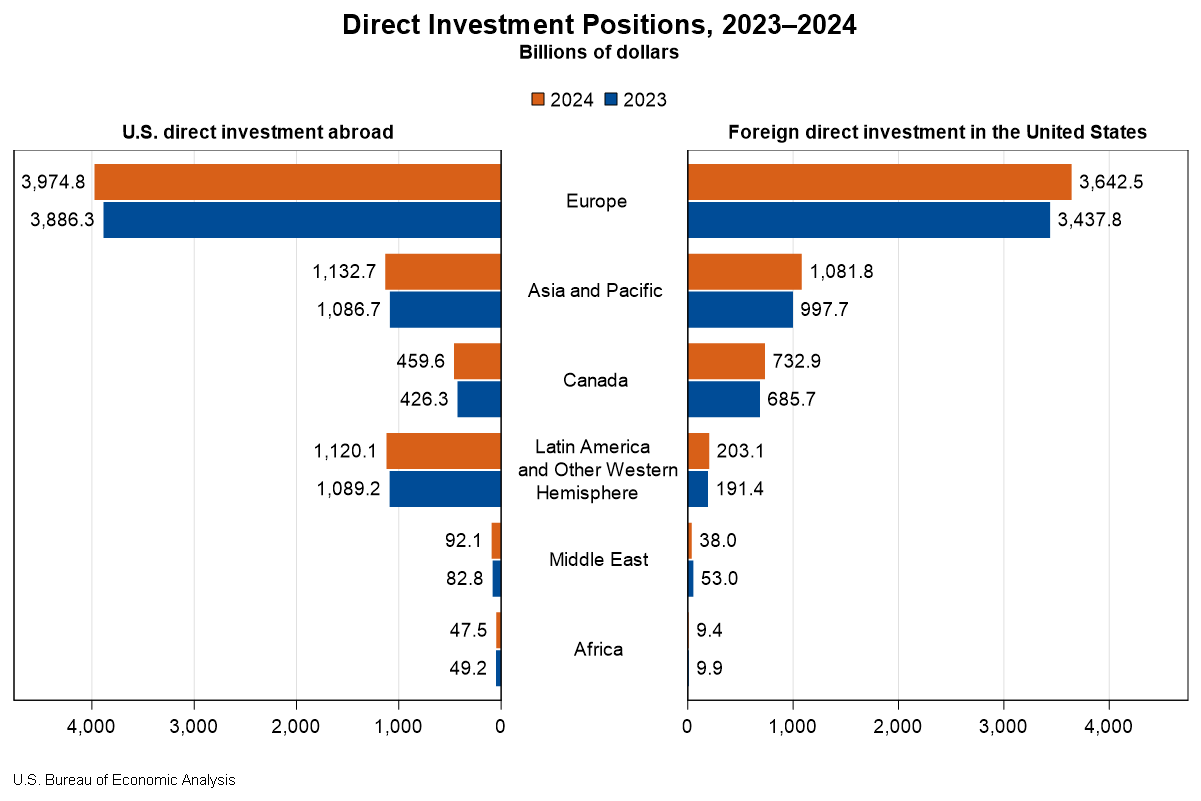Bureau of Economic Analysis
Direct Investment by Country and Industry, 2024
The U.S. direct investment abroad position, or cumulative level of investment, increased $206.3 billion to $6.83 trillion at the end of 2024, according to statistics released today by the U.S. Bureau of Economic Analysis. The increase was led by an $88.4 billion increase in the position in Europe, primarily in Luxembourg and Germany. By industry, manufacturing affiliates had the largest increase, led by manufacturing of computers and electronic products.
The foreign direct investment in the United States position increased $332.1 billion to $5.71 trillion at the end of 2024. The increase was led by a $204.7 billion increase in the position from Europe, which reflected a $52.9 billion increase from the United Kingdom and a $39.7 billion increase from Germany. By industry, affiliates in manufacturing increased the most.
Principal Federal Economic Indicators
Noteworthy
- 2025 News Release Schedule
- Innovation at BEA
- 2025 Annual Updates
- New! Services Trade Data for More Countries
- Data Tool: Trade in Value Added
- Distribution of State Personal Income
- Updated: RIMS II Regional Multipliers
- Arts and Culture
- Space Economy
- FDI Now in State BEARFACTS
- Quick Guide: Price Indexes
The Latest
Gross Domestic Product, 4th quarter and annual 2017 (third estimate); Corporate Profits, 4th quarter and annual 2017
Real gross domestic product (GDP) increased at an annual rate of 2.9 percent in the fourth quarter of 2017 (table 1), according to the "third" estimate released by the Bureau of Economic Analysis. In the third quarter, real GDP increased 3.2 percent.
State Personal Income Rises in 2017
State personal income increased 3.1 percent on average in 2017, after increasing 2.3 percent in 2016. In 2017, personal income increased in all states and the District of Columbia except one, North Dakota. The percent change in personal income across all states ranged from 4.8 percent in Washington to -0.3 percent in North Dakota.
State Quarterly Personal Income, 4th quarter 2017; State Annual Personal Income, 2017 (preliminary)
State personal income increased 3.1 percent on average in 2017, after increasing 2.3 percent in 2016. In 2017, personal income increased in all states and the District of Columbia except one, North Dakota. The percent change in personal income across all states ranged from 4.8 percent in Washington to -0.3 percent in North Dakota.
U.S. Current-Account Deficit Increases in Fourth Quarter 2017
The U.S. current-account deficit increased to $128.2 billion (preliminary) in the fourth quarter of 2017 from $101.5 billion (revised) in the third quarter of 2017. As a percentage of U.S. GDP, the deficit increased to 2.6 percent from 2.1 percent. The previously published current-account deficit for the third quarter was $100.6 billion.
U.S. International Transactions, 4th quarter and Year 2017
The U.S. current-account deficit increased to $128.2 billion (preliminary) in the fourth quarter of 2017 from $101.5 billion (revised) in the third quarter of 2017. As a percentage of U.S. GDP, the deficit increased to 2.6 percent from 2.1 percent. The previously published current-account deficit for the third quarter was $100.6 billion.
Initial Estimates Show Digital Economy Accounted for 6.5 Percent of GDP in 2016
The Bureau of Economic Analysis released, for the first time, preliminary statistics and an accompanying report exploring the size and growth of the digital economy. Goods and services that are primarily digital accounted for 6.5 percent of the U.S. economy, or $1.2 trillion, in 2016, after a decade of growing faster than the U.S. economy overall, BEA’s research shows.
From 2006 to 2016, the digital economy grew at an average annual…
Initial Statistics on the Size and Growth of the Digital Economy to be Released Thursday
The Bureau of Economic Analysis will release, for the first time, preliminary statistics and an accompanying report exploring the size and growth of the digital economy at 10:30 a.m. on Thursday, March 15.
The report will be available at BEA’s website, www.bea.gov.
The report will include in its definition of the digital economy three major types of goods and services:
BEA Works with Partners to Understand Differences in Bilateral Trade Statistics
Trade statistics produced by the Bureau of Economic Analysis provide policymakers and other stakeholders with critical information for understanding the role of the United States in the global economy. As the size and complexity of international transactions have increased, BEA is working on a number of fronts to make its trade statistics even better.
January 2018 Trade Gap is $56.6 Billion
The U.S. monthly international trade deficit increased in January 2018 according to the U.S. Bureau of Economic Analysis and the U.S. Census Bureau. The deficit increased from $53.9 billion in December (revised) to $56.6 billion in January, as exports decreased more than imports. The previously published December deficit was $53.1 billion. The goods deficit increased $2.8 billion in January to $76.5 billion. The services surplus increased $0.…
2017 Trade Gap is $568.4 Billion
The U.S. international trade deficit increased in 2017 according to the U.S. Bureau of Economic Analysis and the U.S. Census Bureau. The deficit increased from $504.8 billion in 2016 to $568.4 billion in 2017, as imports increased more than exports. As a percentage of U.S. gross domestic product, the goods and services deficit was 2.9 percent in 2017, up from 2.7 percent in 2016. The goods deficit increased from $752.5 billion in 2016 to $811…




